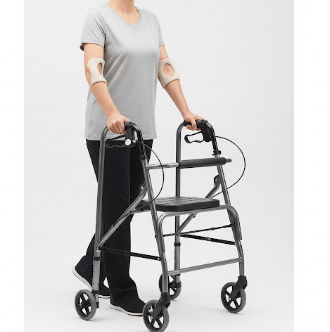Overview
A walker is a mobility aid designed to provide maximum support and stability for individuals with difficulty walking due to injury, surgery, neurological conditions, or age-related weakness. Proper walker use improves balance, safety, and confidence, while reducing the risk of falls.
South Korea offers advanced rehabilitation centers, physiotherapy programs, and mobility clinics, making it a leading destination for patients who need professional guidance on walker selection, training, and long-term mobility support.
What is a Walker?
A walker is a frame that surrounds the user on four sides for support and stability. Key components include:
- Frame → Lightweight yet sturdy metal or composite
- Handles → Ergonomic grips for comfort
- Leg tips or wheels → Rubber tips or small front wheels to provide traction and ease of movement
- Adjustable height → Ensures proper alignment with user’s hips and arms
Indications for walker use include:
- Weakness or instability in both legs
- Post-operative recovery (hip, knee, or lower limb surgery)
- Balance disorders due to neurological or musculoskeletal conditions
- Chronic conditions affecting mobility, such as arthritis or neuropathy
What are the Benefits?
- Maximum stability → Reduces risk of falls
- Weight distribution → Less strain on legs, hips, and lower back
- Enhanced mobility and independence → Enables safe walking indoors and outdoors
- Facilitates rehabilitation → Promotes proper gait and posture
- Customizable in Korea → Wide range of walkers with or without wheels, foldable options, and ergonomic features
- Supports confidence → Encourages patients to remain active safely
Procedure Details
1) How should I prepare before using a walker?
- Consult a healthcare professional → Physiotherapist or doctor to determine the most suitable walker type
- Select the correct height → Walker handles should align with wrists when arms are relaxed at sides
- Check stability → Rubber tips intact or wheels functioning smoothly
- Footwear → Wear supportive, non-slip shoes
- Safe environment → Remove loose rugs, clutter, and ensure smooth walking surfaces
2) How to use a walker correctly?
- Positioning → Place walker about one step ahead of your body
- Walking steps →
- Move the walker forward
- Step forward with the weaker leg first
- Follow with the stronger leg
- Posture → Stand upright, shoulders relaxed, and head facing forward
- Turns and corners → Move slowly, pivoting the walker in small steps
- Stairs and slopes →
- Going up → Lead with stronger leg, walker, then weaker leg
- Going down → Lead with walker, then weaker leg, then stronger leg
- Regular practice → Gradually increase distance and confidence under supervision
3) What happens after proper walker training?
- Improved balance and safety while walking
- Reduced fatigue and strain on lower limbs
- Enhanced independence in daily activities
- Better posture and gait → Less compensatory movement
- Ongoing support → Periodic checkups with physiotherapist to adjust walker and training
Risks / Benefits
Risks
- ➤ Falls if walker height is incorrect or tips/wheels are worn
- ➤ Muscle strain if posture is improper
- ➤ Difficulty navigating stairs or uneven surfaces without assistance
- ➤ Skin irritation or pressure sores on hands from improper grips
Benefits
- ➤ Maximum support and stability for safe walking
- ➤ Reduces risk of falls and injuries
- ➤ Enhances independence and mobility
- ➤ Supports rehabilitation and recovery
- ➤ Customizable options available in Korea for individual needs
Recovery and Outlook
- Immediate improvement → Increased safety and confidence when walking
- Short-term adjustment → 1–2 weeks to learn proper technique and posture
- Long-term outlook → Consistent walker use improves balance, independence, and mobility
- Maintenance → Check walker tips, wheels, and handles periodically
- Lifestyle adjustments → Integrate physiotherapy exercises to strengthen lower limbs and improve endurance
South Korea provides comprehensive walker training programs, including personalized instruction, gait assessment, and rehabilitation support, ensuring safe and effective mobility.
When To Call the Doctor
Contact your healthcare provider if you notice:
- ⚠️ Repeated falls or loss of balance despite proper walker use
- ⚠️ Persistent pain, muscle strain, or fatigue from walker use
- ⚠️ Difficulty using stairs, slopes, or uneven surfaces safely
- ⚠️ Skin irritation, numbness, or blisters from walker handles
- ⚠️ Worsening weakness or inability to walk safely with the walker
Best Korea Option / Process
South Korea is a leading destination for walker training and mobility rehabilitation due to:
- Expert physiotherapists and rehabilitation specialists
- Wide range of walkers and ergonomic assistive devices
- Advanced gait analysis and posture training programs
- Comprehensive rehabilitation programs → Strength, balance, and mobility training
- International patient support, including language assistance, personalized care, and follow-up guidance
Top Facilities for Walker Training in Korea:
- Asan Medical Center, Seoul – Personalized rehabilitation and mobility support
- Samsung Medical Center – Advanced gait and balance training
- Seoul National University Hospital (SNUH) – Specialized walker training and post-surgical rehabilitation
- Yonsei Severance Hospital – Multidisciplinary mobility support and physiotherapy
👉 For individuals with injury, post-surgery recovery, or balance issues, professional walker training in Korea ensures safe, effective, and confident mobility with long-term benefits.













